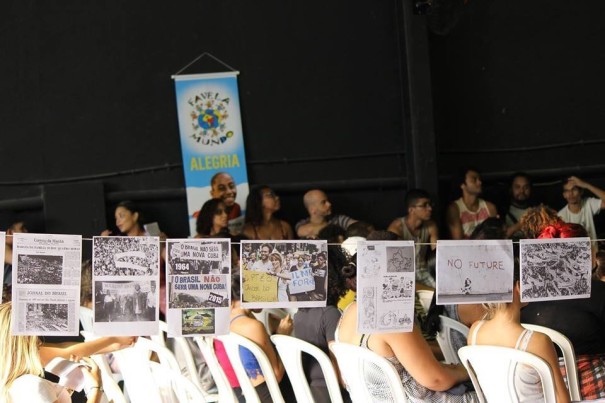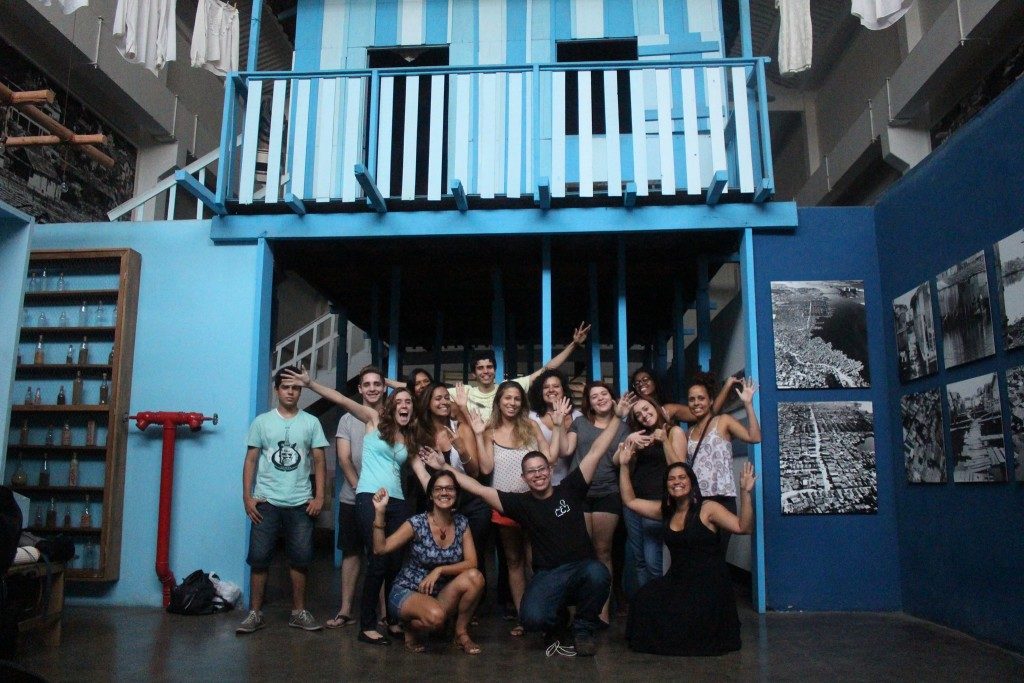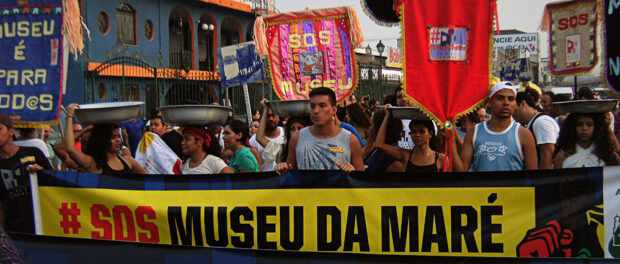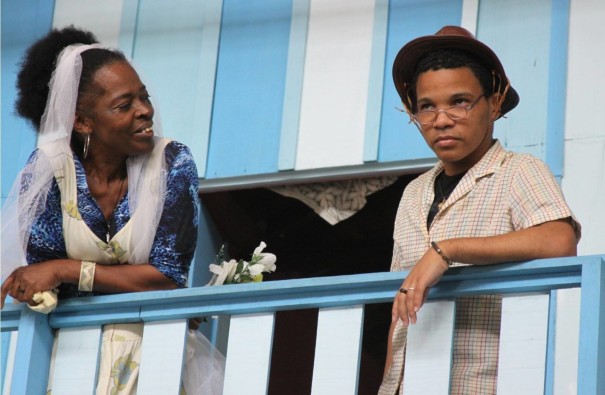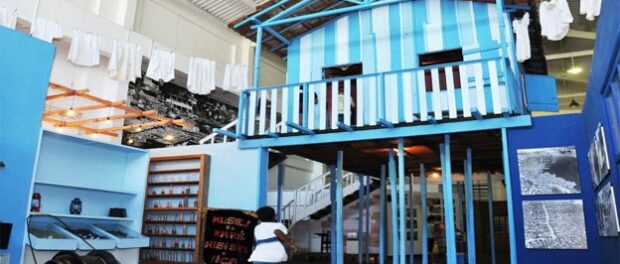
For the original article by Miriane Peregrino in Portuguese published by Jornal O Cidadão click here.
Museu da Maré has existed and fought to remain for 10 years. Today the resistance is against the threat of eviction by Grupo Libra, the company that owns the space where the museum is located.
A museum from the bottom up
On Mother’s Day 2016, Sunday May 8, the home of Maré’s memory–the Museu da Maré– turned 10 years old. Launched May 8, 2006, by a group of residents in Complexo da Maré, the largest complex of favelas in Rio de Janeiro, the museum is a national and international reference in the area of social museology. This is not only due to the fact that it preserves the memory of the lower socio-economic classes, but also because it is a bottom-up initiative from within the favela, shifting the power center of decision-making regarding what is memorable in the city.
“The museum builds a history that is viewed from below and that is separate from official historiography, which is always the story of the winners, the story we are used to hearing since we were children,” observes historian and Maré resident Humberto Salustriano, 37. “The Museu da Maré is the opportunity of telling this story from the perspective of those who are considered subordinate, ‘the conquered.’ This is why the museum is important. It is counter-hegemonic.”
Fransisco Overlande, 42, is also a historian and Maré resident. He affirms that the Museu da Maré helps rupture the stereotypes surrounding the favela and its residents: “The fact that the museum exists is already very symbolic and representative. It contrasts with the idea that museums must have a profile and be in certain areas of the city. Having a museum in the favela ruptures that.” Fransisco illustrates this disruption of stereotypes by recounting the reaction of some taxi drivers when asked to be taken to the Maré museum: “When I say, ‘Leave me at the Museu da Maré,’ the taxi drivers ask: ‘What? There are museums in the favelas?'”
Visual artist and art history professor at the Rio de Janeiro State University (UERJ), Leila Danziger, 54, recently visited the museum and stated that “it was an expansive experience regarding the territories of the city” where she was born and lives. “Visiting the Museu da Maré expanded my capacity to imagine the city in space and time and helps me think of and wish for a city that resists capital, speculation, and dangerously hegemonic narratives, and which becomes more inclusive, human, and complex,” said Leila Danziger, who lives in Copacabana in the South Zone of the city. “From the museum we can understand that in Maré there live and have lived generations that literally built Rio and were perversely excluded from the project of the marvelous city. Of course the Museu da Maré is fundamental for us to imagine the city–imagine in the strong sense. We need not only politics, but also imagination brought by art and literature to shape a city that effectively belongs to everybody.”
Another important aspect to highlight is that the Museu da Maré is not a museum for mere contemplation. The dynamics of acquiring objects and integrating with the space amplify its potential as a non-formal educational space. What most impressed Danziger were the “concepts that structure the museum and guide the visit.” According to her, “the scenography is potent and discreet at the same time, welcoming without sensationalizing or fetishizing memory.”
Although formally established as a museum in 2006, the Museu da Maré’s preservation of the favela’s memory goes back to the 1980s when residents began conducting interviews for Maré TV and producing a large amount of journalistic and historical material on the favela.
Maré residents occupy the museum with diverse activities
Internal projects by CEASM (Maré Center of Solidarity Studies and Actions) and external group projects both from Maré as well as from other parts of the city are also hosted at the Museu da Maré. Francisco Overlande, who is also coordinator of CEASM’s college entrance exam preparatory course, states that classes are held throughout the year at the museum.
“Since the museum was created, we host activities there because the museum is a project of CEASM. Every time extra activities are necessary such as group classes, networking events, or any other specific event that requires a larger space, the museum is the place we use.” Francisco also says that this relationship is not limited to using the physical space, since the educators and students of the course go to the museum also because of the activities it offers.
The college entrance exam course was created in 1997 and annually receives around 150 students who live in and nearby Maré favelas. The community pre-college exam course has a long history of young people from the lower socio-economic classes being approved for public universities in Rio de Janeiro. Just last year, around 30 students from the course gained places at public universities. It is important to highlight that the collective work of the educators is voluntary, without financial compensation.
On May 7, the community newspaper O Cidadão held a class from their annual community communication course at the Museu da Maré. According to O Cidadão reporter and Maré resident, Valdirene Militão, 42, the course always addresses the history of Maré and includes a guided visit to the museum, as well as using the space to host some classes from the course curriculum. “We always host some activity at the museum because of the history of Maré and because of the exhibition,” reports Valdirene, one of the organizers of O Cidadão‘s fourth community communication course. “When we bring students, when we hold classes here, it’s a way of strengthening this space.”
The Maremoto Theater Group, which began in the workshops of the Maré Theater of the Oppressed Center in the community, uses the Museu da Maré to store equipment and rehearse. The idea is to also hold performances at the museum. Vinicius Alves, 19, resident and community representative for Theater of the Oppressed, reported that Maremoto is a play on words that means “Maré in movement of the theater of the oppressed.”
“As a resident, I think it is really interesting to have this museum and for us to have a space here where we can rehearse just proves that the museum was made for the residents. So much so that not only are we here, but there are also other workshops that cater to the population too,” affirms Vinícius Alves.
“This museum (as) a space here where we can rehearse just proves that the museum was made for the residents..” – Vinícius Alves
Carlos Gonçalves, 25, a Maré resident and member of the Rio de Janeiro Youth Forum, recalls that it was through the event they held using the Museu da Maré space that they began to promote the app “Nós Por Nós” (Us for Us) in the favela complex: “The Museu da Maré provided space for us to perform an intervention here in Maré and promote the app. The process of promoting the ‘Nós Por Nós’ app in Maré began here at museum. The museum has always helped us by providing space for human rights activities and social movements, especially for this debate on the issue of the genocide of black youth.”
Visitors describe their experiences at the Museu da Maré
Students from O Cidadão‘s fourth community communication course, Carolina Marinho, Ítala Barros, Josiane Santana, and Luana de Moraes, who had class at the Museu da Maré commented on their impressions of the place. “I graduated in journalism, but the real school for me has been here,” began Carolina, a resident of Complexo do Alemão. “I’m in touch with incredible people who are showing me another perspective of what it means to narrate the day-to-day life of a community, what it is to actually communicate, and the museum… I’m completely enchanted. It’s the first time I’ve been here.”
Josiane Santana, also a resident of Complexo do Alemão, was also impressed by the museum: “When I set foot here and came in through the room, I already thought the museum was fantastic. It’s a very different museum from what we’re used to seeing. I felt as if I were at home. When I saw these pictures in the shack…”–she said, pointing to the walls of the house–“it reminded me a lot of my grandmother’s house, the pictures, the old photos. It brings back a lot of family memories, you know? This thing of the past, of what our great-grandmother’s house or our grandmother’s house was like. I found it very cozy, very familiar, and it moved me.”
Ítala Barros, resident of São João de Meriti in the Baixada Fluminense, associated the museum with memories of the Rio suburbs: “I think today is the best class because this place is very big, very beautiful, and has a wealth of detail that doesn’t only tell the story of Maré, but also discusses the history of the suburbs. I think everyone who comes in here will find at least one thing that reminds them of their grandmother, great-grandmother, or someone from their family, because there are a lot of converging points!” stated Ítala.
Luana de Moraes also found it fundamental to have class there: “It’s the type of communication I believe in, and seeing this happen in practice is totally different than when I would see and reflect on it, you know? So it’s been incredible for my life, for my profession. I’m going to think of other ways to go beyond academics, and I think that’s essential.”
One of the organizers of the course, Valdirene Militão, recalled the impact that the wooden shack displayed at the museum caused on her first visit: “I love the museum. It’s my kind of thing. This little shack… My house, which was a shack, was just like this one. The first time I came here I was moved. I cried. My mother cried. My sister cried. My niece got to know the place where we lived. Today people see a lot of brick houses, and when you talk about shacks, they don’t really have a notion of what they are.”
“I love the museum. It’s my kind of thing. This little shack… My house, which was a shack, was just like this one. The first time I came here I was moved. I cried. My mother cried. My sister cried. My niece got to know the place where we lived. Today people see a lot of brick houses, and when you talk about shacks, they don’t really have a notion of what they are.” – Valdirene Militão
Leïla Danziger, professor at UERJ, reported that she would gaze at the shacks of Maré when she would go down Avenida Brasil by car. She stated that she did not know how much of this memory is mixed with photos she’s seen.
“This memory, although vague and uncertain, was activated by the visit to the museum, which combines history, memory, and fiction, and which thus produces and projects possible identities and destinies onto those who live in Maré and all Cariocas. There, everyone is invited and welcome–those who live in the Maré communities and those who pass by car far away. By visiting the museum, you can include territories of the city based on other parameters, distinct from the violence propagated by the media” argues Danziger. “The Museu da Maré–at that particular place, with its specific history (which resists speculation…)–is fundamental for the city to resist and open up in multiple narratives and more dignified possibilities of life, because it is marked by the memories and singularities of each person, each group, each generation…”
Right to memory: the current situation at the Museu da Maré
Since September 2014 when the Museu da Maré received am eviction notice from the Grupo Libra de Navegações company, the team at the museum (of which I was a part at the time) has maintained a campaign for the continuity of the museum at the building. At that time, Complexo da Maré was occupied by the armed forces in an attempt by the state to promote security (or at least the sensation of security) for the national and foreign tourists visiting the city for the FIFA World Cup in Brazil. The real estate speculation that occurred with the militarization of Rio’s favelas after the introduction of the Pacifying Police Units (UPPs) and also measures considered to be urgent such as occupation by armed forces seemed to be the main cause for the Libra Group’s request to return the property. After almost two years, the campaign that had begun with huge participation in a protest against the end of the museum on Avenida Brasil turned into more timid demonstrations of support and many attempts of dialogue by the board of directors of the museum with the Grupo Libra de Navegações company through the government.
According to the coordinator of the Museu da Maré, Cláudia Rose Ribeiro, the museum’s situation hasn’t advanced: “The situation remains practically the same. The document that guarantees our stay here was valid until March 1, and that deadline has passed. No other documents were signed to delay it. So, what we know is that it is through the State Culture Secretariat that we can talk with the representatives of the company. They extended our stay until May 1, but this does not have a legal consequence because no documents were signed,” stated Cláudia Rose.
With the end of the extension in March of this year and a verbal extension that ended on May 1, the Museu da Maré doesn’t have any other legal instrument that allows their permanent or temporary stay at the building on Avenida Guilherme Maxwell, in Morro do Timbau. Cláudia Rose reports that they are awaiting a referral by the Ministry of Culture, but recalls that the current situation regarding the federal government interferes in the progress of the process: “We are in partnership with the Rio de Janeiro State Secretariat of Culture and the Ministry of Culture. The Ministry of Culture is checking possibilities of how to resolve this situation so as to benefit the museum, so that the museum can remain. But [following the impeachment] everything could change,” said Cláudia Rose.
According to Luiz Antônio de Oliveira, one of the directors of the Museu da Maré, the disputes and problems surrounding the museum become more and more complex because the company who owns the property is associated with the Brazilian Democratic Movement Party (PMDB), the main party that opposed the continuity of the Workers Party (PT) in the government. “This is already public–any Google search will show that there is a connection between Eduardo Cunha and Grupo Libra, with Temer as well, through parliamentary amendments approved in Brasília to favor Grupo Libra in contract bids and other things. It is also public that they support election campaigns here in Rio de Janeiro state and some on the national level as well. So, there is this political element that can also help or hinder us, depending on how things go”–reports Luiz Antônio before concluding–“Also, the connection of Grupo Libra with PMDB was evident in that video by [comedian] Gregório Duvivier where he cites the relationship between Temer and Grupo Libra. So there is this political matter.”
Luiz Antônio continues: “The attitude of the people at Libra is very uncompromising, not only with us, but with the government too. More recently, IBRAM (Brazilian Museums Institute) also joined in with more force, we think because of a request by Boaventura de Souza Santos, the Portuguese sociologist, who was impressed by the museum and talked with us a lot. He acted together with the Ministry of Culture to see which paths we could take to avoid eviction. Regarding the city government, we have no type of support, they did not take a side in the sense of making something possible in favor of the place, the museum, and our actions,” states Luiz Antonio. Thus, with the current political configuration, the uncertainties regarding the future of the Museu da Maré increase. Cláudia Rose says: “This is the situation. And the museum team has already decided, and decided a long time ago, that they will not go unless by force. And then to get rid of us there is the matter of the courts, the repossession order, the police will have to come to enact the order, and that’s it. That’s what’s going to happen if there is not a solution that favors the museum.”
“The museum team has already decided, and decided a long time ago, that they will not go unless by force.” – Cláudia Rose
Barbara Assis, 18, resident of Maré, actor and member of the museum’s storytelling group, states that the museum cannot leave that place: “This museum has a history, impressions, there are people from all over the world who have been here. There are no words to express what I feel regarding this removal. But what most describes how I feel is the notion of inhumanity, lack of love for one another. If you look with sensibility, you can see that this place cannot be anywhere other than here,” says Bárbara Assis, recalling the emotional relationship that involves space, memory, and residents.
According to Leon Diniz, geography teacher at CEASM for over 15 years and one of the collaborators in the occupation of the museum space, the legal fragility of the museum is the result of a political game that has long been played by the dominant classes: “When it is time for the likes of State Security Secretary Beltrame to appear, Mayor Eduardo Paes shows up, but when it’s time to effectively do something that would benefit the residents, the powers that be don’t care about it,” summarizes Leon Diniz.
“When it’s time to effectively do something that would benefit the residents, the powers that be don’t care.” – Leon Diniz
The configuration of public policies of Rio de Janeiro–not only for executing major sporting events, but also to enable a market-based city in a process of gentrification–impacts communities from the South Zone to the West Zone, in addition to strategic territories such as the Maré group of favelas in the North Zone. This reveals the fragility of community actions on various fronts–culture, education, human rights, etc.–in the face of corporate power legitimated through money, through capital, and which determines many of the government’s actions.
Today, aside from the Museu da Maré, another two community museums are threatened with eviction: the Museu de Favela (MUF) in Pavão-Pavãozinho and Cantagalo and the Museu do Horto in Horto.
Thainã Medeiros, a resident of Complexo do Alemão, is one of the organizers of the Evictions Museum in Vila Autódromo, an area devastated by the Rio de Janeiro city government under the justification of building the Olympic Park. He affirms that memory is a strong instrument for constructing identities and resistance, and communities such as Aldeia de Imbuí in Niterói and Horto in Rio use old documents to prove they are not invaders and have occupied these communities for a long time–in other words, they use tools of memory.
“Analyzing the forces that are threatening these museums, I think there is very little attempt (by authoritative groups) to strengthen the autonomy of these museums within the realities of favelas,” declares Thainã Medeiros. “I have little hope for the traditional museum form gaining resistance–the stone and lime format gaining some resistance without institutional support. And it is very unlikely that this institutional strengthening will come from the government or something like that. I have little hope, especially during the current political moment we are in–municipal, state, and federal. I have little hope that there will be a strengthening of these institutions from other institutions.”
“We can, to a certain point, compare the situation of physical instability of these community museums with the Vila Autódromo Neighborhood Association… In this exhausting process of removals where residents are constantly creating strategies to fight back and reinvent and strengthen themselves, the Neighborhood Association ceased to be bricks and mortar and became flesh and bone.”
We can, to a certain point, compare the situation of physical instability of these community museums with the Vila Autódromo Neighborhood Association. After the house where the association functioned was demolished by the City, the association became itinerant, moving from the home of one resident to another as the removals went on. The houses that are still standing say “Neighborhood Association.” In this exhausting process of removals where residents are constantly creating strategies to fight back and reinvent and strengthen themselves, the Neighborhood Association ceased to be bricks and mortar and became flesh and bone, represented in the physical figure of the very resident that resists eviction. This attitude reminds one of the Mexican saying: “They tried to bury us, but they did not know we were seeds.”
The fight continues! 10th anniversary of the Museu da Maré
To the lower socio-economic classes, the right to housing and the right to memory are constantly denied, an addition to the list of human rights violations underway in a city that each day becomes more similar to merchandise, a product on the shelf of those who have money and can pay for the silencing of the big media and the connivance of politicians. The ability of the poor to reinvent themselves is undeniable, but until what point will these communities have to reinvent themselves? Until what point will the poor have to create and recreate counter-hegemonic alternatives? The time of the future is a question mark, but a question mark that is answered by the daily practice of fighting against the capitalist system and for a society that is more dignified and fair to all.
“The ability of the poor to reinvent themselves is undeniable, but until what point will these communities have to reinvent themselves?”
The celebration of the Museu da Maré’s 10th anniversary includes the production of a documentary and the publication of books, as well as the Memory Tea Party which was held on May 19. “The 10 year anniversary fell on a Sunday, which is Mother’s Day, so we decided to have a program during National Museum Week from May 16-22,” states Cláudia Rose, coordinator of the Museu da Maré. “On the 12th we had the first workshop of collective construction of the documentary ’10 Years of the Museu da Maré’ at 3pm, open for people to contribute [so we could] create the video together.”
The Museu da Maré also published some books as part of the celebrations of the ten years of the museum. Luiz Antônio explained, “There was one about the 12 times of Maré, which is a book with images and some texts on the times of the museum. There was another on the Guanabara Bay with articles written by Magalhães Correa who wrote for the Correio da Manhã newspaper and wrote the book O Sertão Carioca in 1936. The book will greatly benefit historians. By the end of the year, we intend to launch a revised edition of Contos e Lendas da Maré (Tales and Legends of Maré). We also plan on creating a book about the Maré neighborhood, but that is being looked into, because we will require resources to publish it.”

